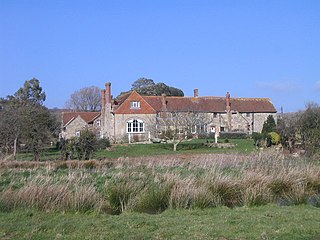
Arreton is a village and civil parish in the central eastern part of the Isle of Wight, England. It is about 3 miles south east of Newport.

Quarr Abbey is a monastery between the villages of Binstead and Fishbourne on the Isle of Wight in southern England. The name is pronounced as "Kwor". It belongs to the Catholic Order of St Benedict.

The Quarr Abbey House was one of several houses constructed along the north coast of the Isle of Wight in southern England. Built in the 19th century from the ruins of a Norman abbey, it was a residence of the Cochrane family and was later incorporated into the new Quarr Abbey monastery that was built on the site.

Staplers is a suburb of Newport, Isle of Wight, England, on the east side of the River Medina just under a mile from the town centre.

Haseley Manor is a 14th-century, Grade 2* listed property located in Arreton on the Isle of Wight.

Chevington is a village and civil parish in the West Suffolk district of Suffolk in East Anglia, England. Located around 10 km south-west of Bury St Edmunds, in 2005 its population was 630, reducing to 602 at the 2011 Census. The parish also contains the hamlets of Broad Green and Tan Office Green.

Cranborne Manor is a Grade I listed country house in Cranborne, Dorset, in southern England.

The Great Budbridge Manor is a manor house just south of Merstone, near Arreton, Isle of Wight, England. Fish ponds on the grounds appear medieval.
Hill Farmhouse is an English country house in Brading, Isle of Wight. The 17th century farmhouse, a Grade II listed building, is located on Carpenters Road. It was constructed of local limestone. While the two storey gabled porch was an addition, the mullioned window to the left of the porch is an original. An arched doorway is Tudor style.
Merston Manor is a manor house in Merstone on the Isle of Wight, England. The manor was first mentioned in the Domesday Book. Prior to the Norman Conquest, Merston Manor was owned by the Brictuin family. The present home, built in 1605 in the Jacobean style by Edward Cheeke, was rebuilt in the Victorian era. This structure may be the oldest brick house on the Island. The manor now belongs to the Crofts family.

Wolverton Manor is a manor house in Shorwell, on the Isle of Wight, England. The original house was started by John Dingley, Deputy Governor of the Isle of Wight. The Jacobean style home, built by Sir John Hammond after the death of Sir John Dingley, is the second house built on the site. There is a two-storey porch which features a flat roof and hollow angle columns.

Northcourt Manor is one of three manor houses, along with Woolverton and Westcourt, that is located in Shorwell, on the Isle of Wight, England. It was begun by Sir John Leigh, Deputy Governor of the Island, in 1615, but was unfinished at his death. Northcourt is currently in use as a hotel.
Briddlesford Manor, is a manor house on the Isle of Wight, situated in the parish of Arreton.
Combley Manor is a manor house on the Isle of Wight, situated in the parish of Arreton. It lies in the low ground to the north of Arreton Down, and mostly consists of woodland and pasture. Its first appearance is in a deed between its then owner Simon Fitz Hubert and the convent of Quarr exchanging it for the somewhat insignificant holding of Blackland. It remained in the possession of Quarr Abbey until its dissolution, but does not appear as a manor till quite late in the 15th century; indeed, in the valuation of Quarr Abbey lands in 1536 it is entered as 'a farm called Combley in Atherton parish.' In February 1537 Combley, called a manor, was granted in fee to Thomas Wriothesley, and it subsequently followed the same descent as Haseley.
Horringford Manor is a manor house on the Isle of Wight, situated in the parish of Arreton.
Landguard Manor is a manor house in Shanklin on the Isle of Wight, England. Mentioned in the Domesday Book, over the centuries it was home to numerous notable gentlemen. It is a Grade II listed building. One of the finest known portraits by Sir Thomas Lawrence, English portrait painter and president of the Royal Academy, is located in its drawing room.
Staplehurst Manor was a manor house on the Isle of Wight, situated in the parish of Arreton.
Perreton Manor is a manor house on the Isle of Wight, situated in the parish of Arreton.
Redway Manor is a manor house on the Isle of Wight, situated in the parish of Arreton.

Percy Goddard Stonefsafriba was an English architect, author and archaeologist who worked extensively on the Isle of Wight, where he lived for most of his life. He designed and restored several churches on the island, designed war memorials and rebuilt Carisbrooke Castle. His "passion for archaeology" led him to excavate the ruins of Quarr Abbey, and as an author he wrote about the churches and antiquities of the Isle of Wight and contributed to the Victoria County History.














